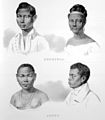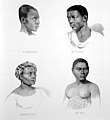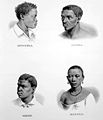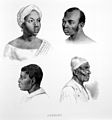Afro-Brazilians: Difference between revisions
m →Cuisine: Dendê oil |
No edit summary |
||
| Line 3: | Line 3: | ||
|image=[[Image:Pelé.jpg|52px]][[Image:Brazil.GilbertoGil.01.jpg|65px]][[Image:Ronaldinho-7-5-2006.jpg|70px]][[Image:Machado assis.jpg|59px]] |
|image=[[Image:Pelé.jpg|52px]][[Image:Brazil.GilbertoGil.01.jpg|65px]][[Image:Ronaldinho-7-5-2006.jpg|70px]][[Image:Machado assis.jpg|59px]] |
||
|caption= |
|caption= |
||
|poptime= "Black": ''c.'' 12 |
|poptime= "Black": ''c.'' 12,908,000 million<br> 6.9% of [[Brazil]]'s population<br> |
||
<br>"[[Pardo]]": ''c.'' 79.782 million<br> 42.6% of [[Brazil]]'s population |
|||
<ref name="PNAD 2005">{{cite web |title=PNAD |year=2006 |url=http://www.ibge.gov.br/home/estatistica/populacao/trabalhoerendimento/pnad2006/brasilpnad2006.pdf |format=PDF|language=Portuguese |accessdate=2007-09-14 }}</ref> |
|||
<br>''c.'' 92.69 million<br> 49.5% of [[Brazil]]'s population |
|||
|popplace= [[Brazil]] |
|popplace= [[Brazil]] |
||
|langs=[[Portuguese language|Portuguese]] |
|langs=[[Portuguese language|Portuguese]] |
||
Revision as of 15:17, 19 November 2008
    | |
| Regions with significant populations | |
|---|---|
| Brazil | |
| Languages | |
| Portuguese | |
| Religion | |
| Predominantly Christianity (majorly Roman Catholic) | |
| Related ethnic groups | |
| Afro-Chilean, Afro-Argentine, Afro-Cuban, Afro-Ecuadorian, Afro-Latin American, Afro-Mexican, Afro-Peruvian, Afro-Trinidadian, Afro-Caribbean, Afro-Jamaicans, Afro-Costa Rican, Afro-Uruguayan |
Afro-Brazilian, or Black Brazilian, is the term used to racially categorize Brazilian citizens who are black or Multiracial.
Brazil has the largest population of black origin outside of Africa[1] with 6.9% classyfing themselves as black (negro) and 42.6% as brown (pardo). The last one is a broad classification that encompasses Brazilians mixed ancestry which includes mulattos and caboclos[2] making the total of 49.5%. The largest concentration of Afro-Brazilians is in the state of Bahia where over 80% of the people are descendants of Africans.[3][4][5]
A large number of Brazilians have some African ancestry and Brazilian populations are remarkably heterogeneous. Due to intensive mixing with Europeans and Native Indians, Brazilians with African ancestors may or may not show any trace of black features[6].
History
Brazil obtained 37% of all African slaves traded, and more than 3 million slaves were sent to this one country. Starting around 1550, the Portuguese began to trade African slaves to work the sugar plantations once the native Tupi people deteriorated. During the colonial epoch, slavery was a mainstay of the Brazilian economy, especially in mining and sugar cane production.
The Clapham Sect, a group of Victorian Evangelical politicians, campaigned during most of the 19th century for England to use its influence and power to stop the traffic of slaves to Brazil. Besides moral qualms, the low cost of slave-produced Brazilian sugar meant that British colonies in the West Indies were unable to match the market prices of Brazilian sugar, and each Briton was using 16 pounds of sugar a year by the 1800s. This combination led to intensive pressure from the British government for Brazil to end this practice, which it did by steps over several decades. Slavery was legally ended May 13 by the Lei Áurea ("Golden Law") of 1888.
Origins
| African settlement in Brazil, from 1500 to 1855[7] | ||||
|---|---|---|---|---|
| Period | 1500-1700 | 1701-1760 | 1761-1829 | 1830-1855 |
| Numbers | 510,000 | 958,000 | 1,720,000 | 618,000 |
The Africans brought to Brazil belonged to two major groups: the West African and the Bantu people.
The West African people (previously known as Sudanese, and without connection with Sudan) were sent in large scale to Bahia. They mostly belong to the Ga, Adangbe, Yoruba, Igbo, Fon, Ashanti, Ewe, Mandinka, and other West African groups native to Ghana, Benin, Guinea-Bissau and Nigeria.
The Bantus were brought from Angola, Congo region and Mozambique and sent in large scale to Rio de Janeiro, Minas Gerais, and the Northeastern Brazil.
During the 1960s, the Portuguese African colonial wars forced small groups of refugees to emigrate to Brazil, especially from Cape Verde and São Tomé and Príncipe[citation needed]. In recent decades, small groups of Portuguese-speaking African countries (PALOP) people are going to Brazil as contract workers and permanent residents[citation needed].
-
African slaves from Mozambique
Genetic studies
| Genetic origin of Brazilian population (Perc.% rounded values) | |||
|---|---|---|---|
| Line | Origin | Negros e pardos (Black & Brown)[8] |
Brancos (Caucasian)[9] |
| Maternal (mtDNA) |
Sub-Saharan Africa | 85% | 29% |
| Europe | 2.5% | 38% | |
| Native Brazilian | 12.5% | 33% | |
| Paternal (Y chromosome) |
Sub-Saharan Africa | 48% | 2% |
| Europe | 50% | 98% | |
| Native Brazilian | 1.6% | 0% | |
A recent genetic study of Afro-Brazilians made for BBC Brasil analysed the DNA of self-reported Blacks from São Paulo.[10]
The research analyzed the mitochondrial DNA (mtDNA), that is present in all human beings and passed down with only minor mutations through the maternal line. The other is the Y chromosome, that is present only in males and passed down with only minor mutations through the paternal line. Both can show from what part of the world a the matrilineal or patrilineal ancestor of a person came from, but on can have in mind that they are only a fraction of the human genome, and reading ancestry from Y chromosome and mtDNA only tells 1/23rd the story, since humans have 23 chromosome pairs in the cellular DNA[11].
Analyzing the Afro-Brazilians' Y chromosome, which comes from male ancestors through paternal line, it was concluded that half (50%) of African-Brazilian population have at least one male ancestor who came from Europe, 48% have at least one male ancestor who came from Africa and 1.6% have at least one male ancestor who was a Native American. Analyzing their mitochondrial DNA, that comes from female ancestors though maternal line, 85% of them have an at least a female ancestor who came from Africa, 12.5% have an at least a female ancestor who was Native American and only 2.5% have an at least a female ancestor who came from Europe[8]. Another study[citation needed] showed that Brazilian white population also resulted of centuries of intense miscegenation. Although Brazilian white population has almost ever (98%) at least an European ancestor on paternal line, 62% has at least a non-European ancestor on the maternal line. Surprisingly, most of them descent from at least one Native American woman (33%) than from at least one Sub-Saharan African woman, although the difference is small.
The high level of European ancestry in Black Brazilians through paternal line exists because, for much of Brazil's History, there were more Caucasian males than Caucasian females. So inter-racial relationships between Caucasian males and Sub-Saharan African or Native American females were widespread[12].
| Caucasian Brazilians and Caucasian Americans with 10% or more of Sub-Saharan African genes[9] | |||
|---|---|---|---|
| Region | Perc.(%) | ||
| Brazil - Northern, Northeastern and Southeastern regions |
75% | ||
| Brazil - Southern region | 49% | ||
| United States | 11% | ||
The same genetic research concluded that 45% of Brazilians (77 million people) would have 90% or over Sub-Saharan African genes. Over 75% of Caucasians from North, Northeast and Southeast Brazil would have over 10% Sub-Saharan African genes, according to this particular study. Even Southern Brazil that received a large group of European immigration, 49% of the Caucasian population would have over 10% Sub-Saharan African genes, according to that study. However, a research showed that the average European American type as approximately 10% to 12% non White genetic material[11].
Thus, according to those studies, 86% of Brazilians would have at least 10% of genes that came from Africa. However, these results are far from being conclusive since they were restricted to a relatively small area of Brazil and involved not a large sample. Indeed, since other studies[citation needed] have given entirely different results we an only conclude that it is really difficult to assess the levels of African, European and Amerindian ancestries in all Brazil given the racial complexity and extension of this country.
As an example, one thousand individuals from Porto Alegre city, Southern Brazil, and 760 from Natal city, Northeastern Brazil, were studied in relation to 12 and 8 genetic systems, respectively. The gathered data were used to estimate quantitatively the ethnic composition of individuals from these communities. More than half of the genes present in individuals classified as Black in Porto Alegre city are of European origin, while the Whites from this city have 8% of African alleles genes. The estimated degree of admixture in persons identified as White or Mixed in Natal city is not much different. According to this study, Natal people carry on average almost 60% European genetic material and about 25% Sub-Saharan African on the matrilineal side (mtDNAline), contrasting with the 44% figure of the previously mentioned study. The ancestry of the total sample can be characterized as 58% White, 25% Black, and 17% Indian [13]
-
Crioulo (Brazilian born) slaves -
Slave women from various African regions wearing European-style hairdressing -
African slaves from Monjolo, Elmina, Mozambique, Benguela e Calava
Culture

The Afro-Brazilian culture is the result of many African Sub-Saharan cultures that evolved in Brazil and were influenced mainly by the Portuguese and Native American cultures. Brazil has the largest population of black origin outside of Africa[14] with 6.9% classifying themselves as black (negro) and 42.6% as brown (pardo), a broad classification that encompasses Brazilians of mixed race ancestry, mulattos, and assimilated indigenous people ("caboclos"),[2] making the total of 49.5%. The largest concentration of Afro-Brazilians is in the state of Bahia where over 80% of the people are descendants of Africans.[15][4][5]
The vast majority of Brazilians have some African ancestry (86%, according to a genetic study). However, because the intensive mixing with Europeans and Native Indians, Brazilians with African ancestors may or may not show any trace of black physiognomy.[6]
Brazil obtained 37% of all African slaves traded, and more than 3 million slaves were sent to this one country. Starting around 1550, the Portuguese began to trade African slaves to work the sugar plantations once the native Tupi people deteriorated. During the colonial epoch, slavery was a mainstay of the Brazilian economy, especially in mining and sugar cane production.
The Africans brought to Brazil belonged to two major groups: the Sudan people and the Bantu people.
The first, generally of high stature and more diverse culture, were sent in large scale to Bahia. (They mostly belong to the Ga, Adangbe, Yoruba, Igbo, Fon, Ashanti, Ewe, Mandinka, and other West African groups native to Ghana, Benin, Guinea-Bissau, and Nigeria.)
The Bantus, natives of Angola, Democratic Republic of the Congo, and Mozambique, were sent in large scale to Rio de Janeiro, Minas Gerais, and the northeastern zona da mata.
In 1960s (when António de Oliveira Salazar ruled as dictator), there were blacks coming from Portuguese African possessions (now PALOP), especially Cape Verde and São Tomé and Príncipe, to Brazil as refugees, and in recent decades, from other African countries and PALOP as contract workers and permanent residents.
Religion

Most Afro-Brazilians are Christians, mainly Catholics. African religions such as Candomblé have millions of followers, mainly Afro-Brazilians. They are concentrated mainly in large urban centers in the Northeast, such as Salvador de Bahia, Recife, or Rio de Janeiro in the Southeast. The capitals of São Paulo and Rio Grande do Sul have fewer practitioners, mainly immigrants from the Northeast. In addition to Candomblé which is the survival of West African religion, there is also Umbanda which blends Kardecist Spiritism beliefs with African beliefs. Candomblé, Batuque, Xango and Tambor de Mina were originally brought by black slaves shipped from Africa to Brazil.
These black slaves would summon their gods, called Orixas, Vodous or Inkices with chants and dances they had brought from Africa. These religions have been persecuted, largely because they are believed to have both good and evil powers. However, the Brazilian government has legalized them. In current practice, Umbanda followers leave offerings of food, candles and flowers in public places for the spirits. The Candomblé terreiros are more hidden from general view, except in famous festivals such as Iemanjá Festival and the Waters of Oxalá in the Northeast.
From Bahia northwards there is also different practices such as Catimbo, Jurema with heavy indigenous elements. All over the country, but mainly in the Amazon rainforest, there are many Indians still practicing their original traditions
Cuisine
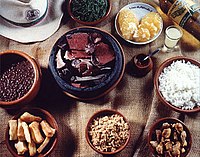
The cuisine created by the Afro-Brazilians has a wide variety of foods. In the State of Bahia, an exquisite cuisine evolved when cooks improvised on African, American-Indian, and traditional Portuguese dishes using locally available ingredients. Typical dishes include Vatapá and Moqueca, both with seafood and dendê palm oil (Portuguese: Azeite de Dendê). This heavy oil extracted from the fruits of an African palm tree is one of the basic ingredients in Bahian or Afro-Brazilian cuisine, adding a wonderful flavor and bright orange color to foods. There is no equivalent substitute, but it is available in markets specializing in Brazilian or African imports.
Feijoada is the national dish of Brazil (for over 300 years). It is basically a mixture of black beans, pork and farofa (lighly roasted coarse cassava manioc flour). It started as a Portuguese dish that the African slaves built upon, made out of cheap ingredients: pork ears, feet and tail, beans and manioc flour. It has been adopted by all the other cultural regions, and there are hundreds of ways to make it.
Capoeira

Capoeira is a martial art developed initially by African slaves came especially from countries as Angola or Mozambique in Brazil, starting in the colonial period. It is marked by deft, tricky movements often played on the ground or completely inverted. It also has a strong acrobatic component in some versions and is always played with music. Recently, the art has been popularized by the addition of Capoeira performed in various computer games and movies, and Capoeira music has featured in modern pop music (see Capoeira in popular culture).
Music
The music created by Afro-Brazilians is a mixture of Portuguese, indigenous, and African music, making a wide variety of styles. Brazil is well known for the rhythmic liveliness of its music as in its Samba dance music. This is largely because Brazilian slave owners allowed their slaves to continue their heritage of playing drums (unlike U.S. slave owners who feared use of the drum for communications).
-
Capoeira or the Dance of War
by Johann Moritz Rugendas, 1835
Literature
Afro-Brazilian literature has existed in Brazil since the mid-19th century with the publication of Maria Firmina dos Reis's novel Ursula in 1859. Yet, Afro-Brazilian literature did not gain national prominence in Brazil until the 1970s with the revival of Black Consciousness politics known as the Movimento Negro.
See also
- Ethnic groups in Brazil
- Batuque
- Candomblé
- Kalunga
- Liberated Africans in Nigeria
- Macumba
- Quimbanda
- Racial democracy
- Umbanda
- Helvécio Martins
- Tambor de Mina
- Chica da Silva (person)
References
- ^ Newint.org
- ^ a b Cite error: The named reference
PNAD 2005was invoked but never defined (see the help page). - ^ Estados@
- ^ a b Edward Eric Telles (2004). "Racial Classification". Race in Another America: the significance of skin color in Brazil. Princeton University Press. pp. 81–84. ISBN 0691118663.
- ^ a b David I. Kertzer and Dominique Arel (2002). Census and Identity: The Politics of Race, Ethnicity, and Language in National Censuses. Cambridge University Press. pp. 63–64. ISBN 0521004276.
- ^ a b Estudos Avançados - Pode a genética definir quem deve se beneficiar das cotas universitárias e demais ações afirmativas?
- ^ IBGE - Instituto Brasileiro de Geografia e Estatística
- ^ a b Afrobras - DNA do negro
- ^ a b As pesquisas na Bahia sobre os afro-brasileiros
- ^ BBCBrasil.com - Notícias - Raízes Afro-brasileiras
- ^ a b DNAPrint Genomics Genealogy website
- ^ A mestiçagem é sinônimo de democracia racial?
- ^ HELENA, M; FRANCO, L. P.; WEIMER, Tania A.; SALZANO, F. M. Blood polymorphisms and racial admixture in two Brazilian populations. Departamento de Genética, Instituto de Biociências, Universidade Federal do Rio Grande do Sul, Porto Alegre, RS, Brazil
- ^ TEODORO, Lourdes (1991). "Black Brazil". New Internationalist (226). New Internationalist. Retrieved 2008-09-03.
{{cite journal}}: Cite has empty unknown parameters:|laydate=,|laysource=,|laysummary=,|quotes=, and|coauthors=(help); Unknown parameter|month=ignored (help) - ^ "Estados@". Instituto Brasileiro de Geografia e Estatística website. Brazilian Institute of Geography and Statistics. 2008. Retrieved 2008-09-03.
Further reading
- Ankerl, Guy. Coexisting Contemporary Civilizations: Arabo-Muslim, Bharati, Chinese, and Western. 2000, Geneva. INUPRESS, ISBN 2881550045. Pp.187-210.

